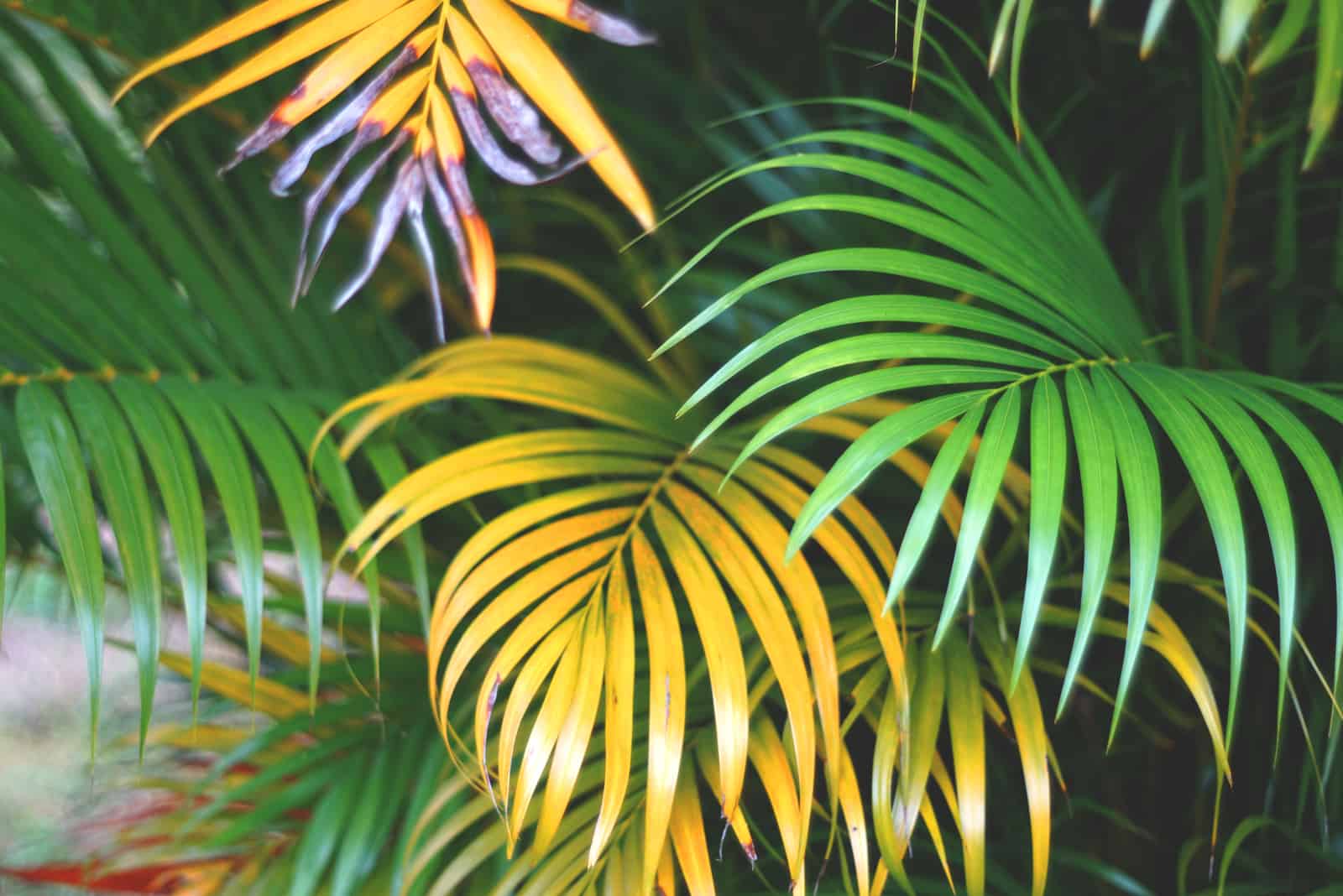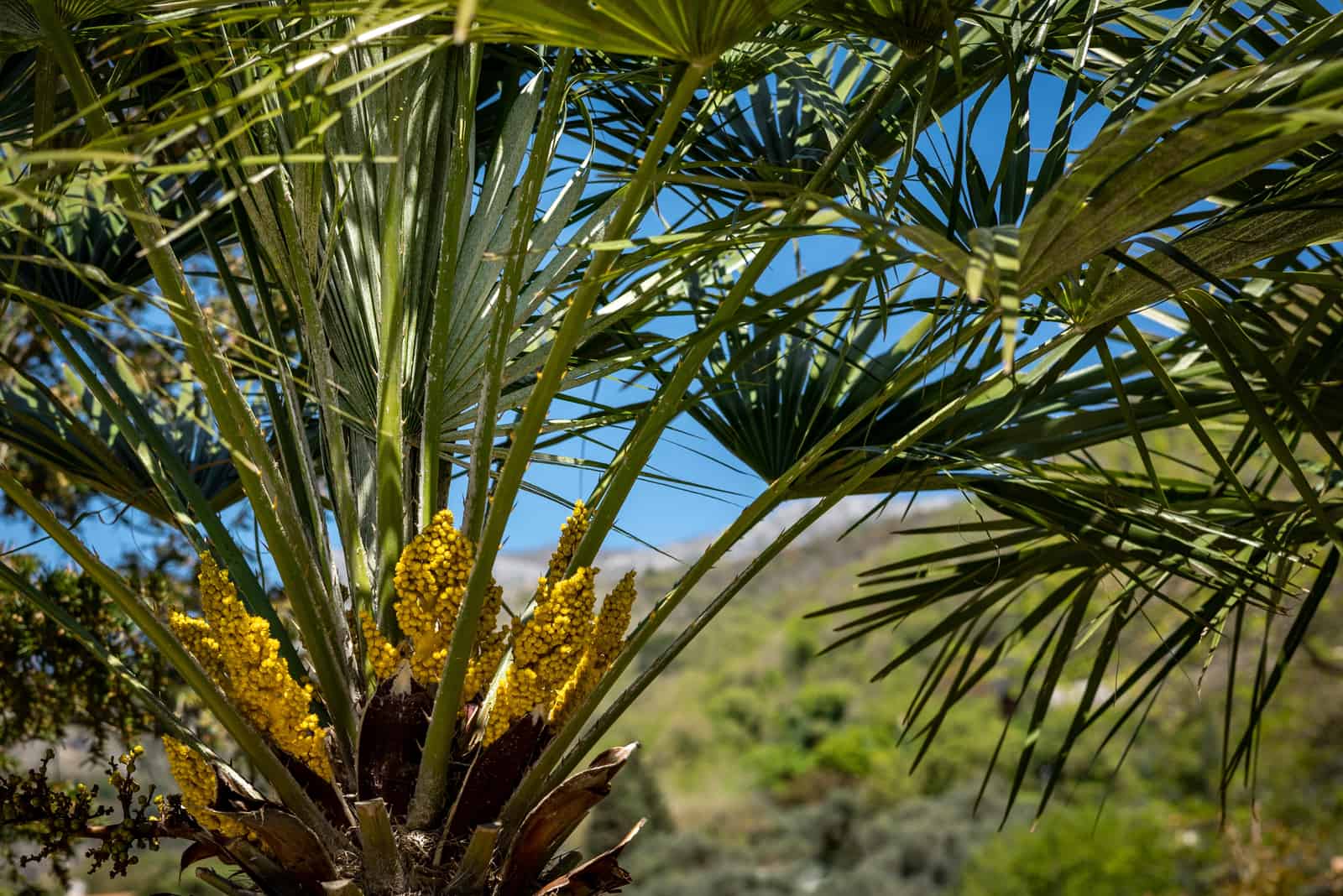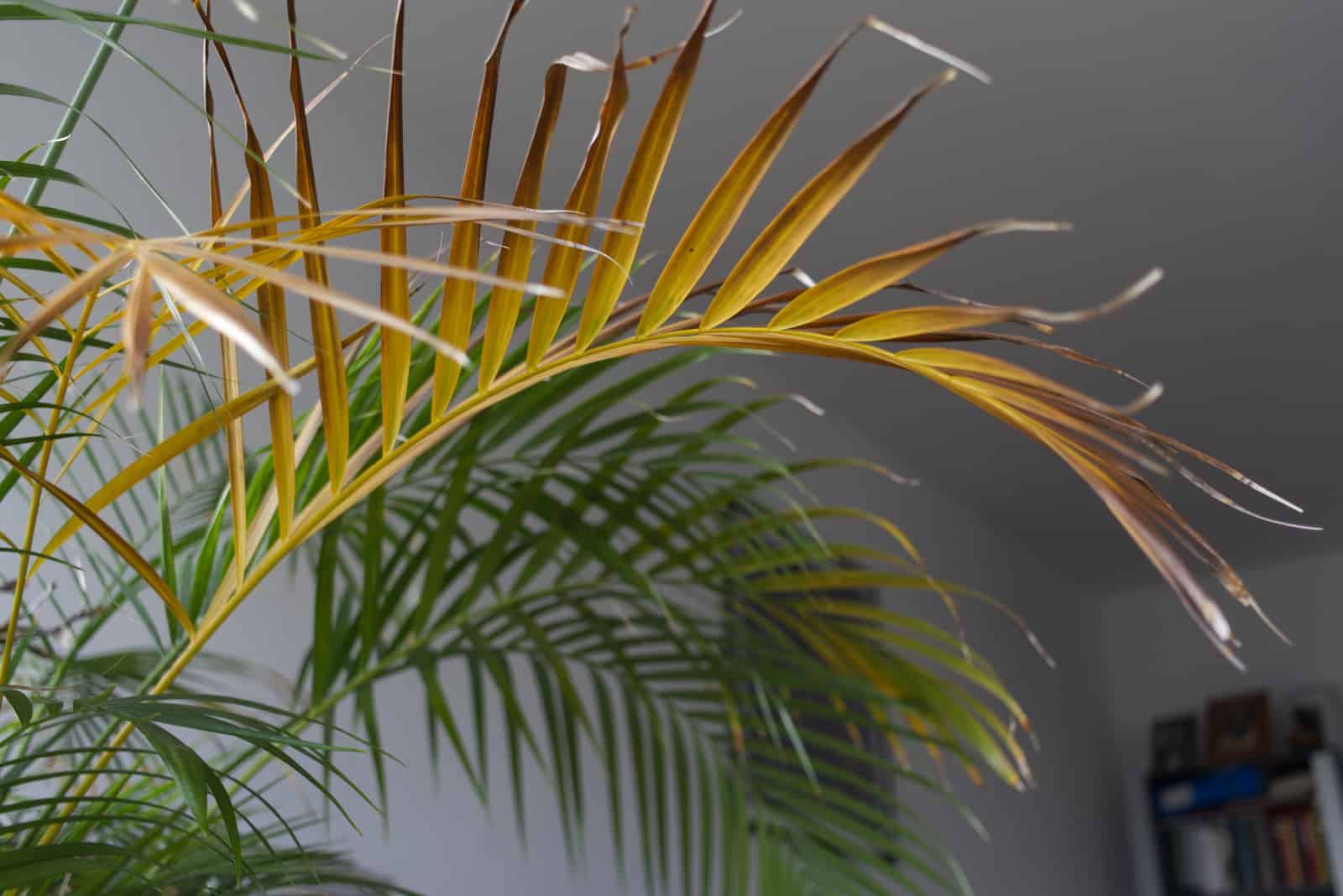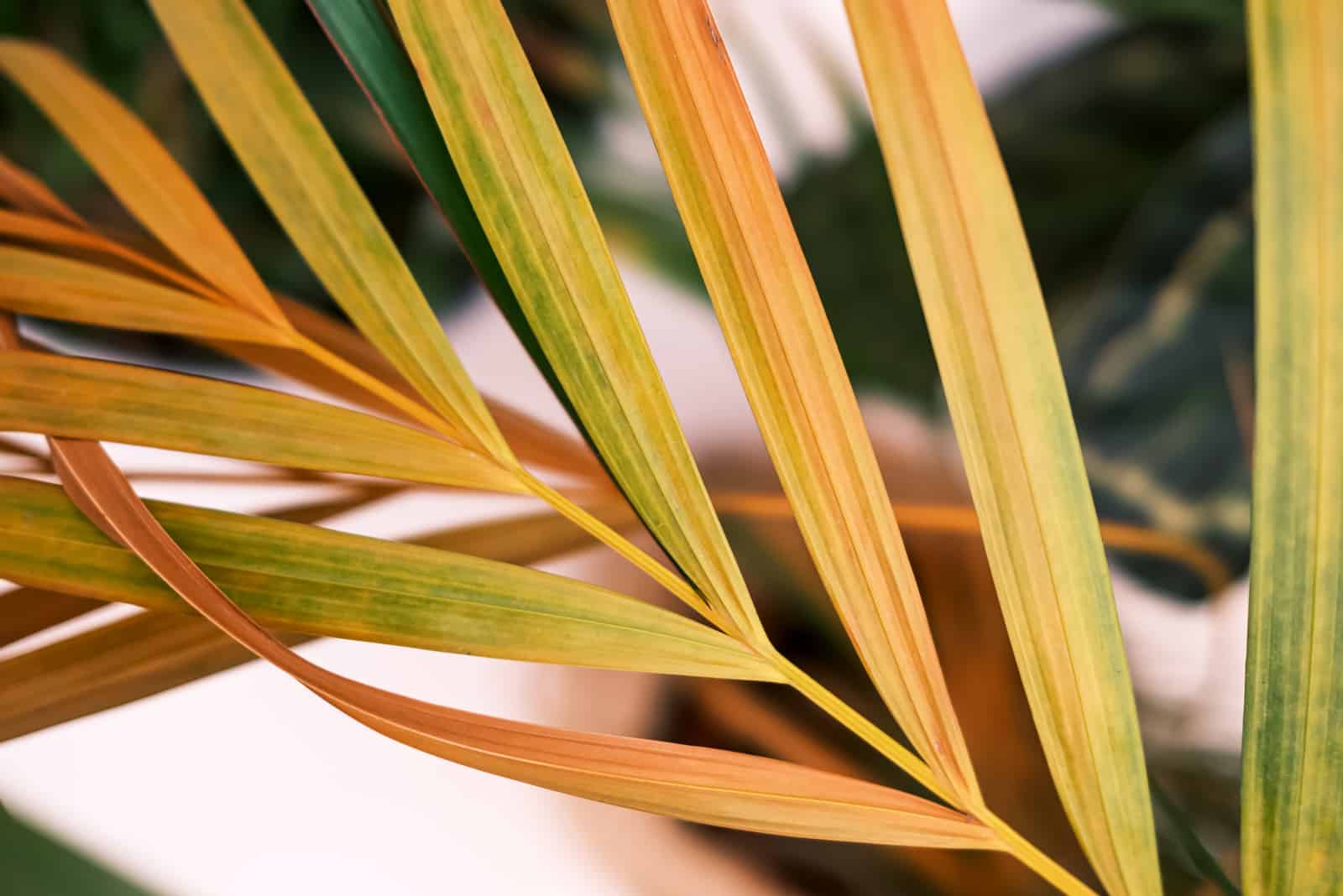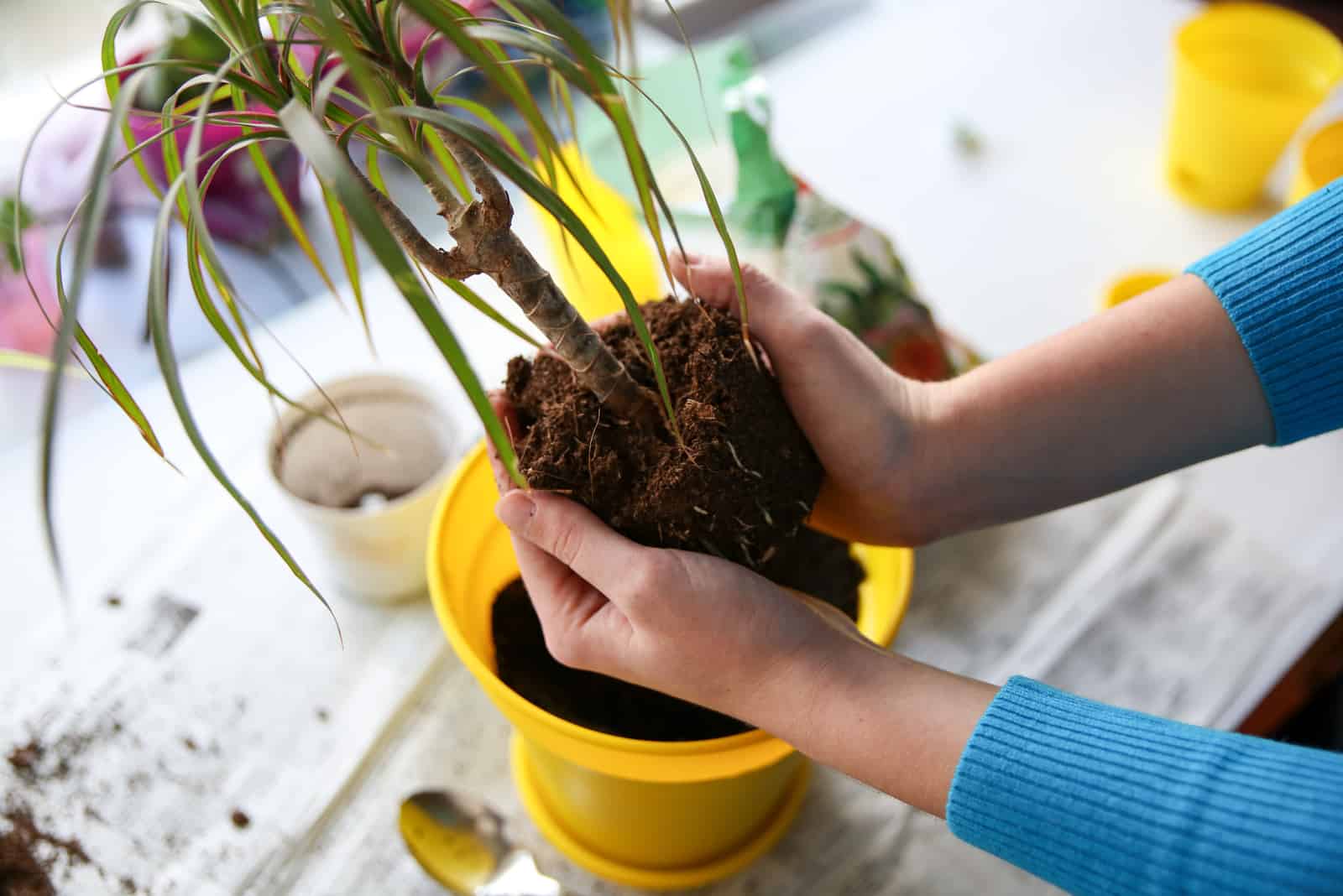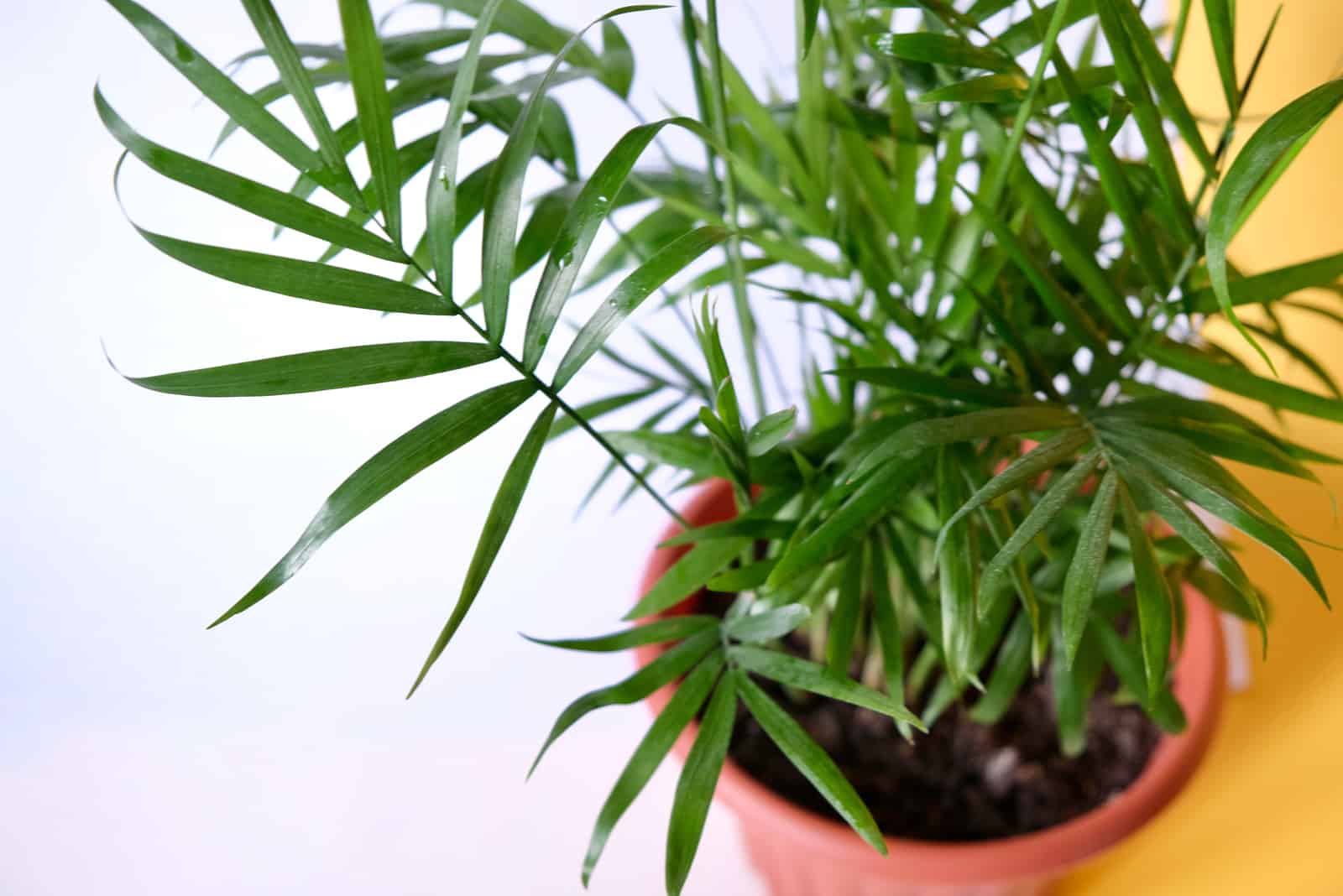If you notice any yellow leaves on your palm tree, I’m sure you are worried. There are many possible causes, but we’ll put your mind at ease with this article about taking care of your precious palm.
Although the causes of leaves turning yellow may not always be severe, there are some that can lead to your plant dying.
That’s why you must inspect any yellow palm leaves immediately, closely followed by the entire plant! The sooner you start, the greater the chances of recovery.
All the parts of a plant are connected, so issues in the soil may result in changes in the leaves, and so on.
You’ll need to take a closer look at your palm tree to determine the cause of the leaves turning yellow. Read on to discover how to fix the problem.
Let’s get started!
Yellow Palm Leaves: Causes
The ideal conditions for your palm tree include infrequent watering, occasional fertilization, partial shade, and temperatures above 50 degrees Fahrenheit.
As you might guess, if any of these conditions aren’t ideal it can cause damage to the plant.
Overwatering, underwatering, too little or too many nutrients, pests, too much light, high or low temperatures, and disease can all be the reasons for yellow leaves.
Let’s get into details!
Palm Leaves Turning Yellow: Overwatering
An overwatered palm tree displays yellow leaves due to the excess water in the pot.
Root rot is a disease that can be lethal if you don’t react to it on time. The roots rot if the soil gets more water than it needs.
If the fronds don’t get enough oxygen from the roots, they will turn yellow. The roots suffocate in case of overwatering, so the fronds respond by turning yellow.
Other Signs Of Overwatering
If there is overwatering, you will also notice other changes to your plant, like:
• Brown leaves: They may occur as a part of the natural life cycle of your palm. As your plant matures, some leaves may turn brown.
• Brown tips: If you notice that the tips of the palm’s foliage turn brown after the leaves turn yellow, your plant is most likely overwatered. Act quickly as this may be followed by leaf spots, and in this case your plant will have a low chance of recovery.
• Mold on the soil: Moldy soil is another sign of an overwatered palm. You’ll need to take the plant out of the pot if this happens.
• Droopy leaves: Too much water in the soil disrupts the airflow, so the roots don’t get enough oxygen to send to the leaves.
• Root rot: If you notice all of the above signs, take your palm out of the pot. Black, brown, or mushy roots are a sure sign of overwatering.
You’ll need to change your watering schedule if you notice any of these signs. Keep reading to determine how much water your palm needs and how often it needs it.
Yellow Fronds Due To Underwatering
Even though palm trees are drought-tolerant, they can still be underwatered.
This is because the soil needs to dry between waterings, but if it dries out completely your plant will display certain changes to tell you it’s thirsty.
Water in the soil promotes nutrient function, and if there isn’t enough water in the soil the fronds won’t have enough nutrients to grow healthy.
Luckily, it’s easier to revive an underwatered palm than an overwatered one. There are other signs of underwatering, so let’s learn about them all.
• Leaf curl: This happens as the leaves try to store as much water as they can by reducing their surface area to save water.
• Dry and brittle soil: This is a sure sign of underwatering and is followed by leaf discoloration.
• Dehydrated and wilting leaves: As well as turning yellow, you’ll notice some leaves have started wilting. This means your plant is thirsty.
• Brown leaf tips: The tips will turn brown if your palm needs water.
Nutrient Deficiency
Fertilization is an essential part of palm plant care. The nitrogen, potassium, magnesium, sulfur, and iron concentration in the soil must be well adjusted.
Here’s how you can tell which mineral your palm is lacking.
Nitrogen deficiency
You’ll first notice that your palm’s older and inner leaves have become yellow. If you don’t add nitrogen to your plant, yellowing will spread to new leaves.
Potassium deficiency
The first indicator of potassium deficiency is yellow leaf edges. The center of the leaf will remain green, and as it progresses the leaf edges will turn brown.
Magnesium deficiency
If there are yellow patches between the leaf veins, your palm is lacking magnesium. However, the veins remain green and yellowing spreads to the outer parts of the leaves.
Finally, you will notice yellow leaf edges.
This problem affects the older leaves.
Manganese deficiency
If you notice yellow streaks on your palm leaves, your plant is lacking manganese. The problem with this deficiency is that it progresses quickly and the yellowing spreads to all the leaves.
Iron deficiency
If there are yellow patches between leaf veins on new fronds, your palm is lacking iron. The branch tops will also become yellow.
Read on to find out how to fertilize your palm, which fertilizer to use, and how often you should do it.
Leaves On A Majesty Palm Turn Yellow: Pest Infestation
The most common palm tree pests are:
• Spider mites
• Scale
• Thrips
• Mealybugs
Pests are frequent visitors of palm plants. However, all indoor plants are attractive to certain pests, palms included.
Spider Mites
Spider mites are widespread in both indoor and outdoor plants, and you’ll likely find them on your Areca Palm.
These mites are frequently reddish in color and build webs on the leaves. They hide on the undersides of palm leaves and suck sap from the plant’s delicate parts.
Luckily, they do not develop to the same size as normal spiders. They are teeny-tiny in size, but may still scare you with their appearance (arachnophobia alert!).
Scale
Another annoying pest you may see on your palm are scale.
These spread quickly, and you’ll have to react as soon as possible if you notice them. If you live in Florida, these are the most common pests you’ll encounter.
Scales are mostly white and thrive on the sap, which makes the plant even more vulnerable.
Thrips
These insects use the same technique as spider mites to suck the fluids from vulnerable sections of the plant, which might explain why your palms’ new growth leaves are damaged.
The other issue is their size, as they are really tiny and hard to spot.
Mealybugs
Mealybugs are one of the most challenging pest problems for plants because they multiply quickly and cause severe damage.
Mealybugs can cause serious damage to young plants if left untreated.
The plant may not survive at all in some circumstances.
You must deal with mealybugs as quickly as possible.
Mealybugs are white-bodied insects that feed on plant juices.
They differ in appearance from other garden bugs, which makes them easier to identify.
Low Light Or Direct Sunlight
Palm trees require a lot of light in order to thrive. Palm fronds will lose their beautiful green color and turn yellow if they don’t get enough light.
The plant can’t make enough chlorophyll in its leaves without light. Chlorophyll is a substance that plants utilize for photosynthesis, and it gives them their green color.
Even though palms need light, they cannot tolerate direct sunlight on their leaves. If exposed to too much direct sunlight, your palm plant’s leaves will burn and develop dry yellow or brown leaves.
Palm fronds lose their ability to produce food, which causes the plant to grow more slowly. The leaves may even die and fall off the plant if they are severely damaged.
Temperature Fluctuations
Palm trees won’t grow well in the cold and can’t withstand sudden temperature changes.
They appreciate steady temperatures as they are unable to move.
Choosing the ideal position for your palm tree is essential if you want to avoid yellowing.
If there are any sudden temperature changes, fronds will show yellowing and wilting.
Yellow Majesty Palm Leaves Due To Disease
High soil moisture creates a perfect environment for harmful fungi to spread.
If there is an infection in the soil, the palm plant will start wilting. The infection will cause the leaves to turn yellow, dry out, die, and eventually fall off.
Let’s look at the most common diseases that affect palm trees.
Bud Rot
Bud rot begins by attacking the plant’s stem, which becomes mushy and gray.
Bud rot symptoms include yellow, burned, and wilted leaves. This is a difficult disease to detect early because the fungus initially takes hold inside the plant before spreading to the outside.
Look between the cracks and crevices of any questionable buds to see if the core is rotting and detect early bud rot.
If the plant’s core appears to be wet and brown, bag it and isolate that portion. After that, take samples and look inside your other plants to see if the bud rot has spread. Follow the same steps if you come across any more sick plants.
Root Rot
Root rot is a prevalent issue that affects houseplants. The reason it appears is because waterlogged soil allows the fungus to spread undisturbed.
Many varieties of fungus Fusarium oxysporum inhabit soil and produce fusarium wilt, which is a widespread plant disease.
1. oxysporum can live in soil without access to living host plants and thrives in temperatures above 75°F.
Infected palms typically become stunted, with pale green to golden yellow leaves that wilt, wither, die, and fall off. The xylem vascular tissue of the roots and lower stem will develop dark streaks and the roots may rot. Seedlings that become infected wilt and die.
Leaf Spot
Poor air circulation and a moist environment allow the spores responsible for leaf spot disease to attach to palm fronds.
First, you’ll notice tiny brown spots on the leaves. They spread rapidly and grow larger before affecting the other leaves.
Your palm is struggling to survive at this point, and will show stunted growth and become yellow.
Ganoderma Butt Rot
The fungus Ganoderma zonatum causes Ganoderma butt rot. This fungus degrades the lignin in the trunk’s bottom 4–5 feet. The trunk will appear to be hard because it does not create soft rot.
This fungus can be found on any palm tree, including queen palms. This fungus doesn’t infect any other plant family as a major pathogen.
Moderate to severe wilting and a general decrease are possible symptoms. The presence of basidiocarp on the trunk confirms the disease before the palm dies off.
This is a solid, shelf-like structure that will be affixed to the palm trunk’s lowest 4–5 feet. On the other hand, many unhealthy palms do not yield conks before dying.
Transplant Shock
Transplant shock occurs when a plant is moved from one place to another.
Plants that have recently been transplanted will have a limited root system.
Because the roots have been disturbed, they are unable to carry out their normal functions, such as water and nutrient absorption. As a result, your precious palm is more vulnerable to external damage, pests, and infections.
Soil pH
The pH of the soil influences the availability of nutrients to plants, and it may also have an impact on beneficial microorganisms that release nitrogen into the soil.
Your plant won’t get the nutrients it needs if the potting mix is too acidic or alkaline.
Palms prefer soil with a pH range of 6.1 (slightly acidic) to 7.8 (acidic).
If the potting mix is too far to one end of the range, your plant will show nutrient deficiency symptoms like soft, yellowing fronds.
Overfeeding
Although palm trees require fertilization, it is essential not to overfeed them.
Overfertilization causes leaves to become weak, floppy, and yellow.
Overfeeding more or less shocks the plant, which might result in death.
You’ll need a new fertilization schedule in this case.
Low Humidity Levels
Palm trees prefer higher humidity levels of at least 55%. Your plant will let you know if humidity is too low for it as the edges of the palm leaves will turn dry and yellow before turning brown and falling off. Keep a hygrometer in your home to monitor the humidity level.
Low humidity can damage plants over time, so pay attention if you observe any of these signs.
Natural Causes
The leaves of palm tree plants usually turn yellow and die naturally over time.
This is a normal part of the palm leaf life cycle and nothing to be overly concerned about. This is almost certainly the culprit if your plant’s old fronds are gradually yellowing one by one.
How To Fix Yellow Palm Tree Leaves
Now that you know what can cause yellow leaves on your precious palm tree, it’s time to solve the problem.
You’ll need to change some habits in your palm tree plant care, such as the watering and fertilization schedule.
Additionally, you’ll need to adjust the light, temperature, and humidity conditions.
If your palm has suffered severe damage, you might need to repot it.
Let’s get into details!
Adjust Watering
First, let’s discuss how often you should water your palm.
Recently planted palms experience transplant shock and lose a lot of moisture. I suggest watering more frequently during the first two weeks when they are establishing and developing new roots.
If you grow outside, water your newly planted palm tree every day for the first week and every other day for the second week, before returning to your regular watering regimen.
Deep watering is the best method for ensuring the water reaches the roots.
Water your palm tree 1-3 times a week if it’s already established.
Adjust your watering based on the season.
If you grow palms as houseplants, keep the soil moist and water it when it’s dry to touch. The soil shouldn’t be soggy.
Palms grow faster during the summer, which is their growing season, and slower during the winter. In the winter, watering once a week should suffice.
When To Water
You should water your palm when the weather isn’t too hot. Either early in the morning or late in the evening will do.
This is because if you water your palm tree in the middle of a hot summer day, it may scorch or burn the leaves.
You can mist the leaves of your majesty’s palm to clean the dust from them if you decide to use this method, just do so during the cooler period of the day.
How To Water
When it comes to palms, they need deep watering. Gradually pour water onto the soil, but never use all the water at once.
Water it slightly, then wait for a couple of minutes and water again. Repeat this process until you see water coming out of the drainage holes.
In case of an overwatered palm, delay watering until you notice the soil has completely dried out. Never expose your palm to direct sunlight to dry it out as it can result in severe damage.
On the other hand, if the cause of yellowing was underwatering, water your palm more often. Every 2-3 days until you notice signs of improvement is perfect.
Change Fertilizer And Fertilization Schedule
If your plant is lacking nutrients, the first thing you should do is perform a soil test.
It will show you precisely which mineral your palm is lacking and help you decide which fertilizer to use.
When purchasing palm fertilizer, make sure it’s slow-release as it will provide nutrients for an extended period and prevent overfertilization.
Only apply fertilizer during the growing season (spring and summer), as fertilization can lead to leaf burn during the winter months. This is because of the active growth during the growing season.
I suggest you follow all the instructions on the fertilizer label.
Remove Pests
If you notice any pests, the first thing you should do is isolate your palm to prevent the infection from spreading.
In cases of severe infestation, the best thing would be to remove the leaves and dispose of them.
If you have a compost pile, never add infested fronds to it.
Once you’ve isolated your palm, remove the pests using one of the following methods:
• Neem oil – This natural insecticide prevents the pests from reproducing. You can purchase ready made neem spray or mix neem oil, water, and liquid soap to make your own. Spray it on the affected areas and continue spraying until all pests are gone.
• Rubbing oil – This is a great choice to get rid of soft-bodied insects. Rub the infested sections and repeat until the pests disappear.
• Castile soap – This method is excellent for pests, but if scales are the culprits for yellowing, I suggest you apply an alternative method.
• Chemical insecticides – This is a fast and efficient method. However, it should be the last option as some substances it contains are toxic.
Adjust The Light And Temperature
Palms thrive in bright indirect light. If you think direct sunlight caused the yellowing, you’ll need to relocate the plant.
Never place it on a sunny windowsill which gets too much light. If you can’t find another spot, you can put curtains over the windows to create partial shade.
Palms prefer temperatures ranging from 70 to 80 degrees Fahrenheit.
Consider purchasing a thermometer, and never place your palm near radiators, fireplaces, or vents.
Adjust Humidity
The first thing you should do is get a hygrometer to monitor humidity levels. If you need to increase humidity, you can use one of the four following methods:
1. Use the pebble try method. Place your palm on a tray filled with water and pebbles. Never allow the roots to come into contact with water.
2. Place your plants next to each other. By grouping plants, you allow the humidity to spread evenly. Plus, your plant collection looks even more beautiful (if that’s even possible!).
3. Place your palm in a kitchen or bathroom as humidity is naturally higher.
4. Purchase a humidifier as it’ll monitor and increase humidity.
Repot Your Majesty Palm
In case of disease or other severe damage, you’ll need to repot your palm.
Here are the steps:
1. Water your palm a day before repotting to prepare and loosen the soil.
2. Gently lift your palm. Make sure not to damage the roots or disrupt the root ball.
3. Remove the old soil. The roots are delicate, and damaging them can cause your palm to go into shock. Remove damaged roots with sterilized tools.
4. Place your palm in the new pot. Fill the pot with the potting mix, place your palm in it, and add more soil if needed.
Here’s a video on how to repot your majesty palm:
Wrapping Up
Yellowing of leaves is a common issue which may indicate severe damage to your palm. However, most causes aren’t so serious and can easily be fixed.
If you notice yellow palm leaves, you should figure out the cause as quickly as possible.
You might want to adjust some of your palm care habits.
Luckily, your palm can quickly be revived if you react on time.
Now you are well equipped to deal with the issues, so what are you waiting for? Go and save your palm!
Until next time!
Like this post? Share or pin it for later!

